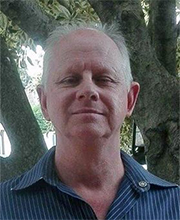
Editor’s Note: In September 2020, Rotary formed a task force charged with assessing the current status of diversity, equity, and inclusion (DEI) in Rotary and shaping a comprehensive action plan to help us further value and live those principles throughout the organization. This is the fourth in a series of blog posts from DEI Task Force members reflecting on their work on the committee and why it is critical for the organization.
Jeremy Opperman joined the Rotary Club of Newlands in Cape Town, South Africa, in 2020. He was born with Retinitis Pigmentosa, a deteriorating eye condition which results in total blindness. He speaks, writes, and consults widely on topics including achieving disability confidence in organizations; making a business case for universal access; and taking a strategic approach to disability inclusion. Read his full bio.
Q: How has your condition shaped your perspective on disability issues?
Jeremy: I didn’t become a diversity practitioner and a disability equity specialist because I was blind. I had a perfectly good career for over 10 years prior to that. But what my blindness did was it gave me credibility in the subject. It gave me a personal understanding of an impairment which is a large contributor to the blind or to the world of disability. As a result, I have been able to pursue these issues with greater understanding and empathy.
Q: You started your own HR marketing consultancy and have been focused on diversity and disability issues, with a particular interest in integrating people with disabilities into the mainstream. What are some lessons or insights you are hoping to share with Rotary leaders on all levels as we work on creating a more inclusive experience for all in Rotary?
Jeremy: I’ve learned a lot from my clients and I started seeing patterns almost immediately, regardless of whether they were an NGO, government, or corporation. Those lessons are important to get across to an organization like Rotary so that we don’t in fact make the same mistakes. One of the most glaringly obvious reasons why corporations struggle with disability and diversity is because leadership is not truly invested. It’s vital that our leadership be invested and knowledgeable about diversity, and especially disability, because it is very nuanced, involved, and complex. The interesting thing about disability equity is that everybody can relate to it rather well because disability is something that could happen to anyone.
Another lesson that I’ve learned is that there is often activity in diversity areas, but organizations might be doing it in an ad hoc, or reactive way. It’s important that we don’t fall into that trap of doing little bits and pieces here and there. Also, there is a tendency to work in silos, so the diversity activities of an organization can be confined to certain silos while other aspects of the business are working in silos that don’t intersect. It’s very important that we ensure there’s integration in all the pillars of an organization such as Rotary. It’s strategic, it’s not just something you do here and there.
Q: You have written about the differences between a surface understanding of accessibility – such as wheelchair access – and a fuller understanding of what it means to have disability equity. What are some barriers that people in general and Rotarians in particular often overlook in creating environments where all can feel comfortable and participate on equal levels?
Jeremy: There is a major attitudinal barrier that is preventing us from embracing disability into mainstream inclusion because for generations and generations, we’ve had a paradigm that embraced exclusion, not unlike the paradigm that kept women down for millennia. We are at the tail end of that, but it’s hard to undo those things.
One of the things I like to write or say is that physical barriers don’t make themselves. Your inaccessible building didn’t make itself; it was made by people. And if people were to think about the disability inclusion idea more, you would have less inaccessibility. That’s what I mean by attitudinal barrier. To overcome the physical barriers, we need to overcome the attitudinal ones. And that’s our greatest challenge.
It’s also vital that we acknowledge that there are issues around digital accessibility, which impacts not only those legally blind, but those with visual impairment, or dyslexia, or people who are older who struggle with the whole digital interface. We must make sure our digital space, our internet, infrastructure, etc., are more accessible. And we need to be quite firm as an organization that we’re going to address that.
Q:Why is it beneficial for everyone to make disability equity a priority in all that we do?
Jeremy: Because inclusion makes more sense than exclusion. If we categorically exclude people, even if we do it without realizing it, we exclude more than just one individual. For instance, picture a restaurant. We all love to eat out, right? Let’s say you’ve got a party of four people and they want to go out. And let’s say one of the four is in a wheelchair — could be temporary, maybe they recently broke their leg. Now the question you want to ask yourself is could you go to absolutely any restaurant you chose? And the chances are that you probably couldn’t, because of an access issue. Did that restaurant lose just one meal, or did they lose the whole party? And so that’s what we call the business case.
Disability inclusion makes business sense. Which is why we see more focus on accessibility in malls and things because people have realized this. From a Rotary perspective, if we want to grow more, we can’t afford to lose people through thoughtlessness and carelessness, or even tacit exclusion. We need to embrace the idea of inclusion so that we can in fact attract even more people than we are thinking of.
Learn more about Rotary’s Diversity, Equity, and Inclusion statement and meet other members of the task force.
https://blog.rotary.org/2021/10/07/shifting-the-paradigm-on-dei/

